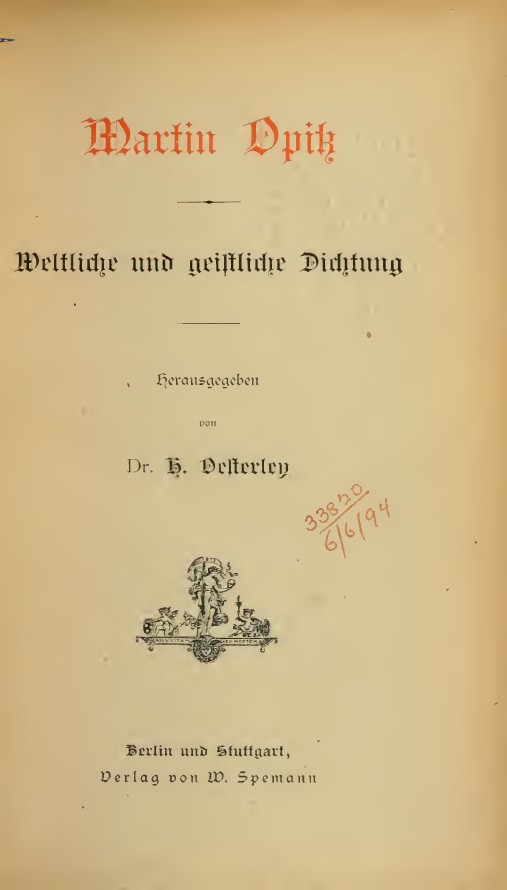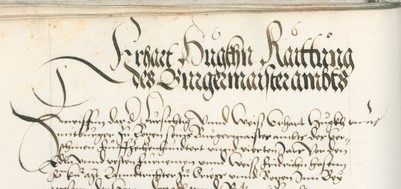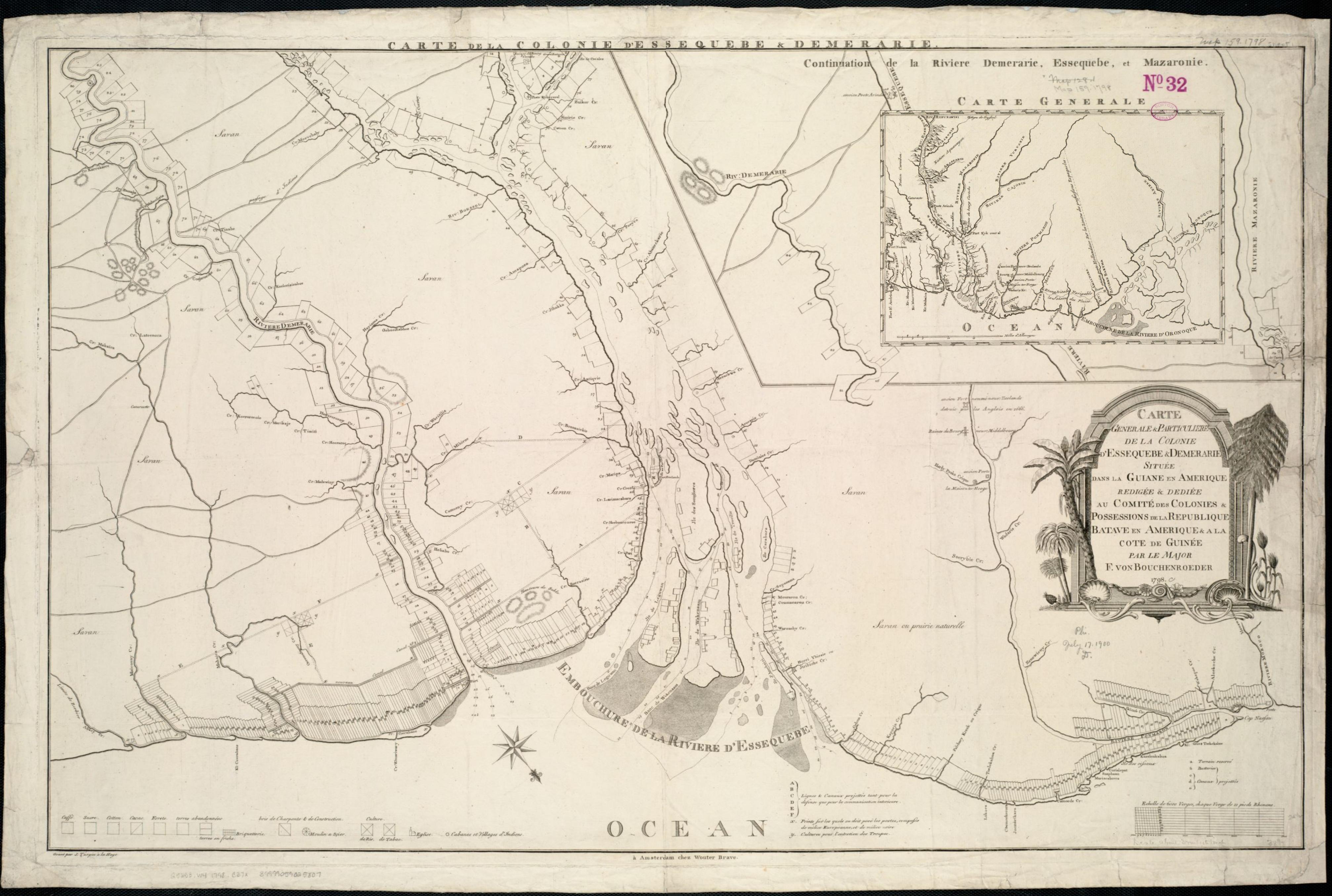|
Christian Hoffmann Von Hoffmannswaldau
Christian Hoffmann von Hoffmannswaldau (baptised 25 December 1616 – 4 April 1679) was a German poet of the Baroque era. He was born and died in Breslau (Wrocław) in Silesia. During his education in Danzig (Gdańsk) and Leiden, he befriended Martin Opitz and Andreas Gryphius, both leading figures in 17th-century German poetry. In his later years, Hofmannswaldau involved himself in the city politics of Breslau, rising to the position of Bürgermeister. During his lifetime, Hofmannswaldau's poems circulated mostly in manuscript. It was the posthumous publication of ''Deutsche Übersetzungen und Gedichte'' in 1679 that assured his reputation as the most influential poet of his era, followed by Benjamin Neukirch's even more extensive collection, ''Herrn von Hoffmannswaldau und anderer Deutschen auserlesener und bißher ungedruckter Gedichte'', the first volume of which appeared in 1695. Hofmannswaldau's style of poetry came to be known as ''Galant'' and is marked by extravagan ... [...More Info...] [...Related Items...] OR: [Wikipedia] [Google] [Baidu] |
Baroque
The Baroque (, ; ) is a style of architecture, music, dance, painting, sculpture, poetry, and other arts that flourished in Europe from the early 17th century until the 1750s. In the territories of the Spanish and Portuguese empires including the Iberian Peninsula it continued, together with new styles, until the first decade of the 19th century. It followed Renaissance art and Mannerism and preceded the Rococo (in the past often referred to as "late Baroque") and Neoclassical styles. It was encouraged by the Catholic Church as a means to counter the simplicity and austerity of Protestant architecture, art, and music, though Lutheran Baroque art developed in parts of Europe as well. The Baroque style used contrast, movement, exuberant detail, deep colour, grandeur, and surprise to achieve a sense of awe. The style began at the start of the 17th century in Rome, then spread rapidly to France, northern Italy, Spain, and Portugal, then to Austria, southern Germany, and Russia. B ... [...More Info...] [...Related Items...] OR: [Wikipedia] [Google] [Baidu] |
Wrocław
Wrocław (; german: Breslau, or . ; Silesian German: ''Brassel'') is a city in southwestern Poland and the largest city in the historical region of Silesia. It lies on the banks of the River Oder in the Silesian Lowlands of Central Europe, roughly from the Baltic Sea to the north and from the Sudeten Mountains to the south. , the official population of Wrocław is 672,929, with a total of 1.25 million residing in the metropolitan area, making it the third largest city in Poland. Wrocław is the historical capital of Silesia and Lower Silesia. Today, it is the capital of the Lower Silesian Voivodeship. The history of the city dates back over a thousand years; at various times, it has been part of the Kingdom of Poland, the Kingdom of Bohemia, the Kingdom of Hungary, the Habsburg monarchy of Austria, the Kingdom of Prussia and Germany. Wrocław became part of Poland again in 1945 as part of the Recovered Territories, the result of extensive border changes and expulsions ... [...More Info...] [...Related Items...] OR: [Wikipedia] [Google] [Baidu] |
Silesia
Silesia (, also , ) is a historical region of Central Europe that lies mostly within Poland, with small parts in the Czech Republic and Germany. Its area is approximately , and the population is estimated at around 8,000,000. Silesia is split into two main subregions, Lower Silesia in the west and Upper Silesia in the east. Silesia has a diverse culture, including architecture, costumes, cuisine, traditions, and the Silesian language (minority in Upper Silesia). Silesia is along the Oder River, with the Sudeten Mountains extending across the southern border. The region contains many historical landmarks and UNESCO World Heritage Sites. It is also rich in mineral and natural resources, and includes several important industrial areas. The largest city and Lower Silesia's capital is Wrocław; the historic capital of Upper Silesia is Opole. The biggest metropolitan area is the Upper Silesian metropolitan area, the centre of which is Katowice. Parts of the Czech city of Ostrav ... [...More Info...] [...Related Items...] OR: [Wikipedia] [Google] [Baidu] |
Gdańsk
Gdańsk ( , also ; ; csb, Gduńsk;Stefan Ramułt, ''Słownik języka pomorskiego, czyli kaszubskiego'', Kraków 1893, Gdańsk 2003, ISBN 83-87408-64-6. , Johann Georg Theodor Grässe, ''Orbis latinus oder Verzeichniss der lateinischen Benennungen der bekanntesten Städte etc., Meere, Seen, Berge und Flüsse in allen Theilen der Erde nebst einem deutsch-lateinischen Register derselben''. T. Ein Supplement zu jedem lateinischen und geographischen Wörterbuche. Dresden: G. Schönfeld’s Buchhandlung (C. A. Werner), 1861, p. 71, 237.); Stefan Ramułt, ''Słownik języka pomorskiego, czyli kaszubskiego'', Kraków 1893, Gdańsk 2003, ISBN 83-87408-64-6. * , )Johann Georg Theodor Grässe, ''Orbis latinus oder Verzeichniss der lateinischen Benennungen der bekanntesten Städte etc., Meere, Seen, Berge und Flüsse in allen Theilen der Erde nebst einem deutsch-lateinischen Register derselben''. T. Ein Supplement zu jedem lateinischen und geographischen Wörterbuche. Dresden: G. Schönf ... [...More Info...] [...Related Items...] OR: [Wikipedia] [Google] [Baidu] |
Leiden
Leiden (; in English and archaic Dutch also Leyden) is a city and municipality in the province of South Holland, Netherlands. The municipality of Leiden has a population of 119,713, but the city forms one densely connected agglomeration with its suburbs Oegstgeest, Leiderdorp, Voorschoten and Zoeterwoude with 206,647 inhabitants. The Netherlands Central Bureau of Statistics (CBS) further includes Katwijk in the agglomeration which makes the total population of the Leiden urban agglomeration 270,879, and in the larger Leiden urban area also Teylingen, Noordwijk, and Noordwijkerhout are included with in total 348,868 inhabitants. Leiden is located on the Oude Rijn, at a distance of some from The Hague to its south and some from Amsterdam to its north. The recreational area of the Kaag Lakes (Kagerplassen) lies just to the northeast of Leiden. A university city since 1575, Leiden has been one of Europe's most prominent scientific centres for more than four centuries. Leide ... [...More Info...] [...Related Items...] OR: [Wikipedia] [Google] [Baidu] |
Martin Opitz
Martin Opitz von Boberfeld (23 December 1597 – 20 August 1639) was a German poet, regarded as the greatest of that nation during his lifetime. Biography Opitz was born in Bunzlau (Bolesławiec) in Lower Silesia, in the Principality of Schweidnitz-Jauer, the son of a prosperous citizen. He received his early education at the gymnasium of his native town, of which his uncle was rector, and in 1617 attended the high school—"Schönaichianum"—at Beuthen an der Oder (Bytom Odrzański), where he made a special study of French, Dutch and Italian poetry. In 1618 he entered the University of Frankfurt-on-Oder as a student of ''literae humaniores'', and in the same year published his first essay, '' Aristarchus, sive De contemptu linguae Teutonicae'', which presented the German language as suitable for poetry. In 1619 Opitz went to Heidelberg, where he became the leader of the school of young poets which at that time made that university town remarkable. Visiting Leiden in ... [...More Info...] [...Related Items...] OR: [Wikipedia] [Google] [Baidu] |
Andreas Gryphius
Andreas Gryphius (german: Andreas Greif; 2 October 161616 July 1664) was a German poet and playwright. With his eloquent sonnets, which contains "The Suffering, Frailty of Life and the World", he is considered one of the most important Baroque poets of the Germanosphere. He was one of the first improvers of the German language and German poetry. Gryphius was born and raised in Glogau (Głogów), Duchy of Głogów, Silesia. At the age of 33, he married Rosina Deutschländer, with whom he had six children, Christian, Constantin, Anna Rosine, Theodor, Maria Elisabeth, and Daniel. Life Early life Andreas Gryphius was the son of Paullus Gryphius, a respected clergyman and a Lutheran archdeacon of Glogau, originally from Uthleben and Paullus' third wife, Anna (née Eberhardin), who was 32 years younger than her husband, the daughter of a businessman from Fraustadt, the councilor Jonas Deutschländer the Elder (died in 1661) and Anna Sachse. He was born in Großglogau (Głogów). T ... [...More Info...] [...Related Items...] OR: [Wikipedia] [Google] [Baidu] |
Bürgermeister
Burgomaster (alternatively spelled burgermeister, literally "master of the town, master of the borough, master of the fortress, master of the citizens") is the English form of various terms in or derived from Germanic languages for the chief magistrate or executive of a city or town. The name in English was derived from the Dutch ''burgemeester''. In some cases, Burgomaster was the title of the head of state and head of government of a sovereign (or partially or de facto sovereign) city-state, sometimes combined with other titles, such as Hamburg's First Mayor and President of the Senate). Contemporary titles are commonly translated into English as ''mayor''. Historical use * The title "burgermeister" was first used in the early 13th century. *In history (sometimes until the beginning of the 19th century) in many free imperial cities (such as Bremen, Hamburg, Lübeck etc.) the function of burgomaster was usually held simultaneously by three persons, serving as an executive co ... [...More Info...] [...Related Items...] OR: [Wikipedia] [Google] [Baidu] |
Italy
Italy ( it, Italia ), officially the Italian Republic, ) or the Republic of Italy, is a country in Southern Europe. It is located in the middle of the Mediterranean Sea, and its territory largely coincides with the homonymous geographical region. Italy is also considered part of Western Europe, and shares land borders with France, Switzerland, Austria, Slovenia and the enclaved microstates of Vatican City and San Marino. It has a territorial exclave in Switzerland, Campione. Italy covers an area of , with a population of over 60 million. It is the third-most populous member state of the European Union, the sixth-most populous country in Europe, and the tenth-largest country in the continent by land area. Italy's capital and largest city is Rome. Italy was the native place of many civilizations such as the Italic peoples and the Etruscans, while due to its central geographic location in Southern Europe and the Mediterranean, the country has also historically been home ... [...More Info...] [...Related Items...] OR: [Wikipedia] [Google] [Baidu] |
Giambattista Marino
Giovanni Battista was a common Italian given name (see Battista for those with the surname) in the 16th-18th centuries. It refers to "John the Baptist" in English, the French equivalent is "Jean-Baptiste". Common nicknames include Giambattista, Gianbattista, Giovambattista, or Giambo. In Genoese the nickname was Baciccio, and a common shortening was Giovan Battista, Giobatta or simply G.B.. The people listed below are Italian unless noted otherwise. * Giovanni Battista Adriani (c.1511–1579), historian. * Giovanni Battista Agnello (fl. 1560–1577), author and alchemist. * Giovanni Battista Aleotti (1546–1636), architect. * Giovanni Battista Amendola (1848–1887), sculptor. * Giovanni Battista Amici (1786–1863), astronomer and microscopist. * Giovanni Battista Angioletti (1896-1961), writer and journalist. * Giovanni Battista Ballanti (1762–1835), sculptor. * Giovanni Battista Barbiani (1593–1650), painter. * Giovanni Battista Beccaria (1716–1781), physicist. * Giovanni ... [...More Info...] [...Related Items...] OR: [Wikipedia] [Google] [Baidu] |
Johann Christoph Gottsched
Johann Christoph Gottsched (2 February 1700 – 12 December 1766) was a German philosopher, author and critic of the Enlightenment. Biography Early life He was born at Juditten (Mendeleyevo) near Königsberg (Kaliningrad), Brandenburg-Prussia, the son of a Lutheran clergyman, and was baptised in St. Mary's Church. He studied philosophy and history at the University of Königsberg, but immediately on taking the degree of ''Magister'' in 1723, he fled to Leipzig in order to avoid being drafted into the Prussian army. In Leipzig, he enjoyed the protection of J. B. Mencke, who, under the name of "Philander von der Linde", was a well-known poet and president of the ''Deutschübende poetische Gesellschaft'' in Leipzig. Of this society, Gottsched was elected "Senior" in 1726, and in the next year reorganised it under the title of the ''Deutsche Gesellschaft''. Career As editor of the weeklies ''Die vernünftigen Tadlerinnen'' (1725–26) and ''Der Biedermann'' (1727), Gottsche ... [...More Info...] [...Related Items...] OR: [Wikipedia] [Google] [Baidu] |
1616 Births
Events January–June * January ** Six-year-old António Vieira arrives from Portugal, with his parents, in Bahia (present-day Salvador) in Colonial Brazil, where he will become a diplomat, noted author, leading figure of the Church, and protector of Brazilian indigenous peoples, in an age of intolerance. ** Officials in Württemberg charge astronomer Johannes Kepler with practicing "forbidden arts" (witchcraft). His mother had also been so charged and spent 14 months in prison. * January 1 – King James I of England attends the masque ''The Golden Age Restored'', a satire by Ben Jonson on fallen court favorite the Robert Carr, 1st Earl of Somerset, Earl of Somerset. The king asks for a repeat performance on January 6. * January 3 – In the court of James I of England, the king's favorite George Villiers, 1st Duke of Buckingham, George Villiers becomes Master of the Horse (encouraging development of the thoroughbred horse); on April 24 he receives the Order of the Gart ... [...More Info...] [...Related Items...] OR: [Wikipedia] [Google] [Baidu] |


.jpeg/1200px-Brama_Zuraw_W_Gdansku_(153003103).jpeg)





